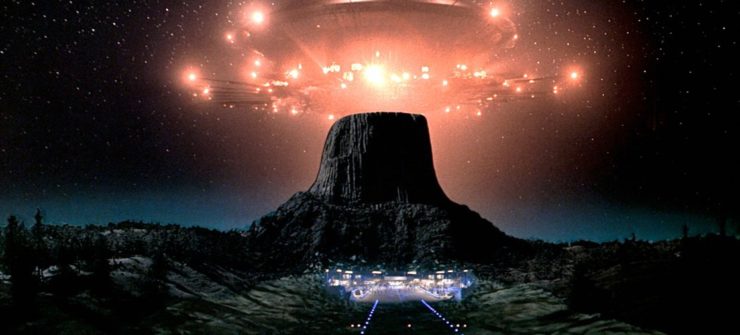If I say “Spielbergian” to you, what do you see? A human face, agape with awe, staring at an alien, a dinosaur, or the Ark of the Covenant? Beams of multicolored light? Children gleefully embracing the unknown, while their adult guardians cower in fear? “Spielbergian” is a feeling. It’s the nebulous, free-floating awe behind 89% of J.J. Abrams’ lens flares. It’s been name-checked on everything from Tiny Toon Adventures to Angels in America. And it was born in an optimistic alien movie in 1977.
When Steven Spielberg began work on his first true passion project, Close Encounters of the Third Kind, he had already made three films: Duel, in which a man is pursued by a faceless, relentless truck driver in a menacing Peterbilt; Sugarland Express, in which a pair of down-on-their luck parents try to restore their nuclear family through a series of action sequences and car chases; and finally Jaws, in which a town is menaced by a faceless, relentless shark, and three humans have to save the sanctity of family vacation through a series of action sequences and boat chases.
Compared to these, Close Encounters is a weird, anomalous movie. We begin with a nuclear family: Roy Neary, his wife Ronnie, and their three kids in a cluttered, noisy house. We only spend a few moments with this family before Roy is sent off to work on a power outage, encounters a UFO, and everything changes.
In the spirit of the 40th anniversary, I rewatched the 1977 theatrical release, which tells a far starker story than the later re-releases rather or either of the re-edits. When we meet Roy in the 1977 version, he’s an overgrown kid. He has a model train, loves playing with his children, and immediately allows himself to be swept away with excitement after his UFO sighting.
Roy’s encounter with aliens isn’t even particularly pleasant, it just isn’t overtly hostile. His truck is lifted slightly, he’s burned by the light from the ship, his stuff flies around. He chases after the ships, but not because he feels like he’s been touched by some otherworldly force—he just wants to know what’s going on. His chase leads him to almost run over little Barry Guiler and his mother, Jillian, who will become the deuteragonists of the film. Thanks to his chase, he gets a much closer view of the ships. Meanwhile, the audience receives something close to confirmation of the events in the plotline of Claude Lacombe, a French scientist who is studying the encounters around the globe, and preparing the U.S. military for first contact. He pores over the mysterious five tones the aliens have implanted in people’s minds, and studies sign language that could be used to communicate to the aliens.
At home, Roy’s wife Ronnie is exhausted, harping on the kids to go to bed, and treating Roy like another child to be scolded. She never seems to believe in the truth of his sighting, even though he can’t explain the burn on his face, or the power outages. She doesn’t want to spend any time speculating, she just wants him to spray fake tan on his face and pretend like nothing happened, but Roy can’t hide for long—whatever has happened is so powerful that he begins to fall apart within days of his initial encounter.
All because of a tower. Roy seems to receive a vision of a mountain that appears to him in everything he sees—Jello, pillows, even his family’s dinner:
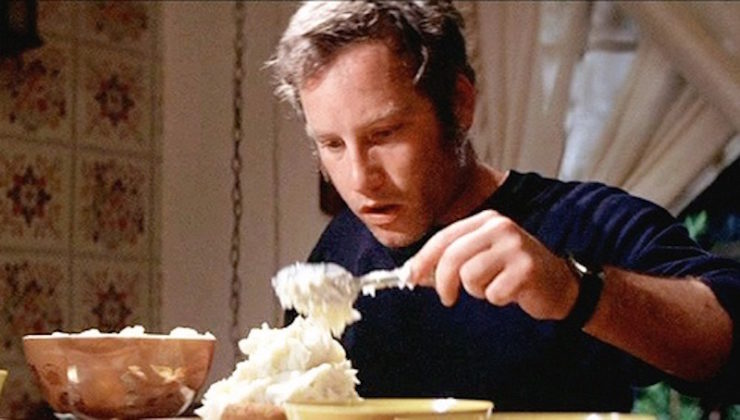
He can’t explain his compulsion. Ronnie seems disgusted with him; his children are clearly terrified.
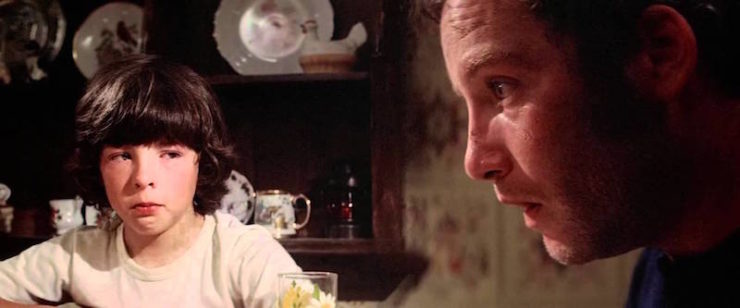
At first, recreating the mountain from clay seems to soothe Roy. He pulls all of his UFO sighting clippings down, and yells to his sleeping wife that everything is OK now. But then he inadvertently pulls the top from his model, and the mania skyrockets. He is driven to recreate the mountain on a larger scale with mud, chicken wire, and bricks…in the middle of the living room. Fed up with his hysteria, Ronnie snaps and leaves with the kids. The next time we see him he’s finished the mountain—it nearly reaches the ceiling—but he’s on the phone with Ronnie and trying to convince her to come back. “It was a joke!” he repeats, lamely, but she hangs up on him. He looks up at the TV just in time to see footage of Devil’s Tower, a mountain in Wyoming that exactly matches the vision he’s been having for weeks.
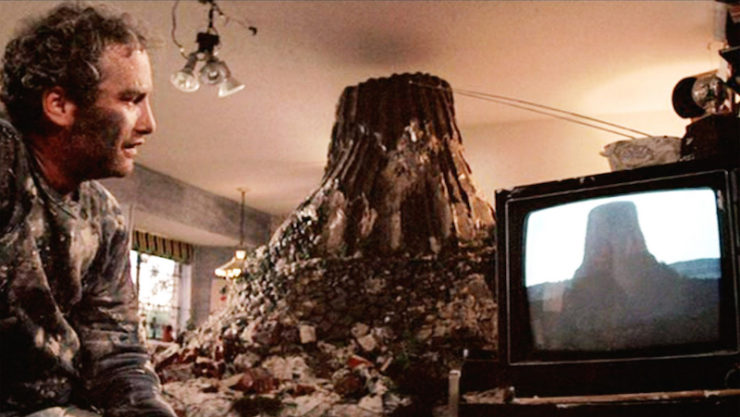
Meanwhile, Jillian’s experience of the UFOs is awe-inspiring in the ancient sense of the word. In a scene that recalls both the Book of Job and The Wizard of Oz, UFOs come to her farm, aliens enter her house, and quickly enchant her child, who wants nothing more than to run away with them. We never know why the aliens have targeted her child, Barry, for attention. He has no fear of them, and runs into the woods to play with them in a scene that predicts ET six years later. Jillian is outside when a giant storm comes tumbling across the sky, flashing with light and wind.
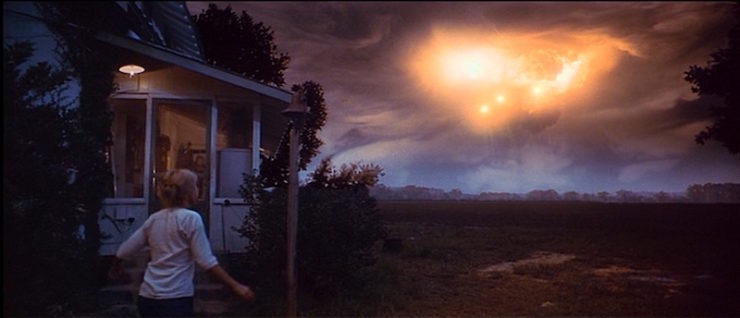
She runs inside, realizing that the aliens have returned, and somehow intuiting that they’ve come for her son. When they come to pick him up, the film turns into a true horror movie for the first time: Jillian locks the doors and windows, closes her fireplace flue, cowers on the floor with her son—none of it matters. The aliens shoot beams of light into the house, turn her appliances on and off, and finally pull Barry through the doggie door. She never sees the aliens, and she is terrified, for all that her son wants to run out to them.
She embarks on a quest to find the aliens again—not because she has any cosmic truth she wants to learn, but only because she hopes to get her son back.
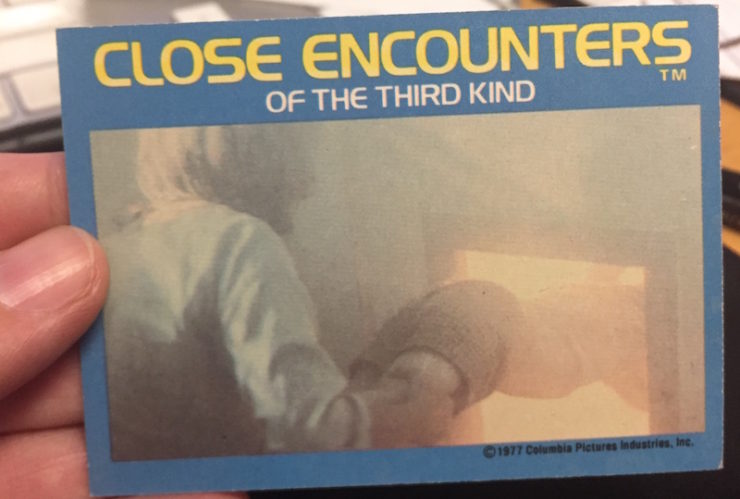
Jillian and Roy are both violently pulled out of their lives. We see Roy maniacally sculpting Devil’s Tower, and when we rejoin Jillian in her hotel room, her walls are covered with sketches and paintings, in ever greater detail. It’s obvious that each time they drew or sculpted the Tower they hoped the vision would finally be appeased, but it just came back stronger. Finding it on TV is the only thing that lets them know they aren’t going crazy, and in a pair of mirroring scenes we watch Roy and Jillian approach their televisions with nigh-religious awe, grazing their fingers over the screen, tracing the outlines of the Tower. Both hit the road to Wyoming to find the Tower, run into each other, and team up for the last leg of the trip.
While their compulsion only grows stronger when they finally get in sight of the Tower, they still don’t actually know what they’re searching for: they know nothing about Lacombe, or the research into the five tones, or the landing coordinates. They are pilgrims overcome with their quest, and they ignore the military’s trumped-up warning about nerve gas, the barbed wire fences, and even blockades of federal agents to get to the Tower. When they’re apprehended, they escape and continue on foot, picking up a fellow traveler named Larry before the military finally pulls out the last-ditch effort of dispatching crop-dusting helicopters loaded with poison. We see birds falling down, seemingly dead, and then Larry is felled as well, collapsing and foaming at the mouth. Has the poison killed him? Or just knocked him out? We don’t pause long enough to learn his fate as the cameras follow Roy and Jillian in their last desperate scramble, and then we all receive the revelation: an airstrip, bristling with lights.
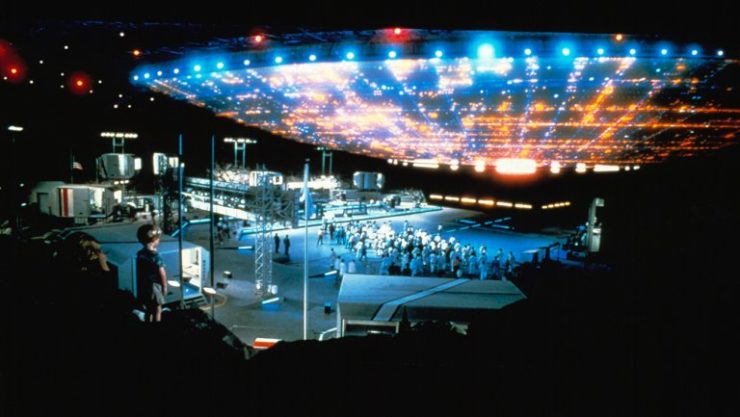
The military and Lacombe have prepared a landing site for the aliens. Roy and Jillian duck behind boulders, watching. They’re rewarded for their tenacity by getting to witness first contact, but even more than that, their deepest wishes are precisely granted. Jillian, realizing that her child isn’t on the ships, prepares to leave—but then the aptly named Mother Ship arrives. She watches it rise above the mountain, land, and spill light as it opens its door. And there is her son Barry, walking down the ramp hand-in-hand with a long-lost American serviceman. The two reunite as dazzled scientists and military personnel look on. No one tries to stop them, no one questions her.
But it’s Roy who truly hits the jackpot, because he’s allowed to leave with the aliens. An ordinary man whose life was upended by mysterious visions not only gets the answers he was looking for, but also receives the opportunity to transcend his mundane existence, leave Earth and family responsibilities behind, and explore space. In the 1977 version of the film, we don’t really get much nuance from Roy; he’s much more of a blank-canvas Everyman, an audience proxy. His sense of awe is not tied to any particular object. He’s not a mother searching for her child, or a religious person looking for meaning, or a UFO nut looking for validation. He’s just a guy who receives a vision, and is overwhelmed with emotion because of it.
And this, truly, is the birth of Spielbergian.
While the one and only religious ceremony in the film is Christian—a priest says a blessing over the cosmonauts who have been chosen to leave with the aliens—the imagery of Close Encounters is resolutely Jewish. Specifically, a form of Judaism that is, just as resolutely, mediated through the language of the Biblical epic. We see The Ten Commandments on TV…but the kids only want to watch it because it’s so long it’ll postpone their bedtime. Roy is driven mad by an overpowering image of a mountain…but the mountain is in Wyoming, surrounded by farmland, and evokes a Western more than anything in Exodus. Barry’s kidnapping is accompanied by an implacable Job-like whirlwind….but the aliens announce their presences by possessing appliances and unscrewing air conditioning grates, as poltergeists and Gremlins would a few years later. But the underlying theme of the film comes through in the many, many scenes of crosstalk, babble, and miscommunication.
Roy and Ronnie never really listen to each other. They yell at cross purposes while their children scream and churn around them. A team of air traffic controllers who receive the very first UFO report interrupt each other, recite stats into phones, and generally create a cacophony. Any scenes involving the military involve a ton of chatter. And in the most basic sense, the closest thing to an authority the humans have to rely on is a French scientist who can barely make himself understood to Americans, and has to rely on a translator who is actually just a cartographer who happened to be available. We never know how good the man’s French is.
Looking at the original stories, we can see just how odd and revolutionary Spielberg’s vision is. The Tower of Babel appears in Genesis 11, built by humans who want to reach the heavens. God is so annoyed at human presumption that He not only destroys the Tower itself, but also hits humanity with a plague of different languages so we’ll never be able to work together on another giant, heaven-reaching project. In the Book of Job, God tests his follower Job with a series of trials and tribulations, the worst of which are the inexplicable death of his family. But when Job dares to question him, God speaks from within a whirlwind, yelling at Job for presuming to know His business:
Where wast thou when I laid the foundations of the earth? declare, if thou hast understanding.
Who hath laid the measures thereof, if thou knowest? or who hath stretched the line upon it?
Whereupon are the foundations thereof fastened? or who laid the corner stone thereof;
When the morning stars sang together, and all the sons of God shouted for joy?
Or who shut up the sea with doors, when it brake forth, as if it had issued out of the womb?
The Lord goes on like this for four chapters, and Job eventually admits that he spoke out of turn.
Finally, the film’s central image of Devil’s Tower seems like an obvious riff on Mount Sinai in Exodus. Moses is the only one allowed to scale the mountain to receive the Ten Commandments, and the scene at the mountain’s foot is awe-inspiring:
And it came to pass on the third day in the morning, that there were thunders and lightnings, and a thick cloud upon the mount, and the voice of the trumpet exceeding loud; so that all the people that was in the camp trembled.
And Moses brought forth the people out of the camp to meet with God; and they stood at the nether part of the mount.
And mount Sinai was altogether on a smoke, because the Lord descended upon it in fire: and the smoke thereof ascended as the smoke of a furnace, and the whole mount quaked greatly.
And when the voice of the trumpet sounded long, and waxed louder and louder, Moses spake, and God answered him by a voice. And the Lord came down upon mount Sinai, on the top of the mount: and the Lord called Moses up to the top of the mount; and Moses went up.
And the Lord said unto Moses, Go down, charge the people, lest they break through unto the Lord to gaze, and many of them perish.
Spielberg takes this imagery and doesn’t give us a Biblical epic. He doesn’t even give us the street-level, grubby theology of, say, a Martin Scorsese film. Instead, he gives us user-friendly awe. The aliens never tell us what they want. We never truly learn what their intent is, what their beliefs are, why they’ve come to see us, why they took the fighter pilots away, why they became obsessed with Barry. The only thing we can infer is that there are several different races of aliens who have worked in harmony to travel to Earth, a point that Spielberg underlined in multiple interviews about the film. Other than that they are blank screens, and we can project our awe onto them.
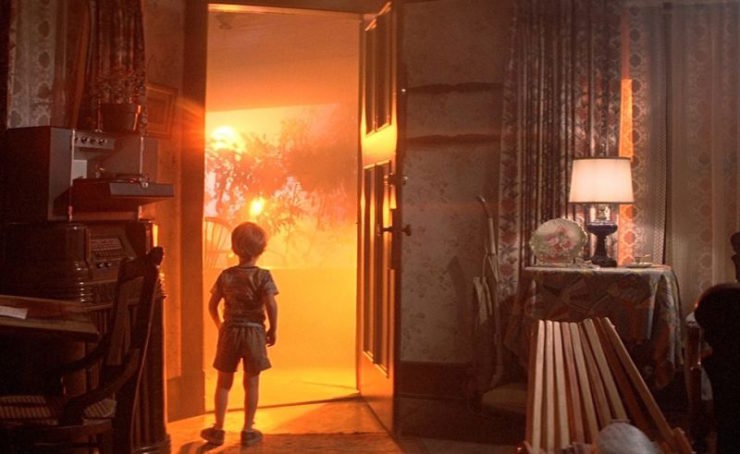
But the one thing that Spielberg commits to is this: the aliens want to communicate with us. Unlike all the humans who talk over each other without ever truly hearing one another, the aliens cut through language itself, resolving their message into the pure image of the tower, the landing coordinates, and the five tones. They are able to bypass words entirely, and engage with us in pre-verbal communication. They give us the initial five tones, and and then improvise on them. The ships swoop around the landing site like playful birds.
Once the mothership lands, the concert gets even more elaborate, and one scientist remarks, “This is the first day of school, fellas,” which puts us in a childlike role, but the aliens don’t seem to see us as a species to be dominated or ordered around—they just want to talk with us. Jillian, who challenged the whirlwind, gets her son back. Roy Neary, who climbed the forbidden mountain, gets to travel into the stars with his new alien friends. And in the end one alien comes down and speaks to Lacombe with sign language, and smiles at him.
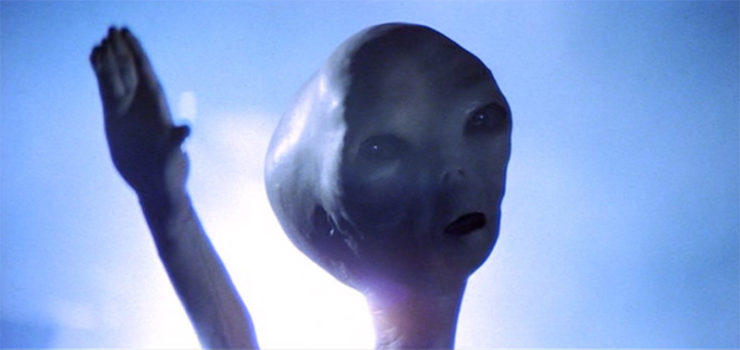
Did…did they learn smiling from us?
Like the aliens in Denis Villeneuve’s Arrival, they don’t want to conquer, they just want to talk to us, while all we humans can do is squabble and self-sabotage. (Especially appropriate, since it was Close Encounters that led Villeneuve to the films of Francois Truffaut.) Could it be that the aliens, too, were alone? That after centuries of searching they were overjoyed to find us, and have someone to talk to?
By using ancient religious imagery to tell a story about aliens, Spielberg prepares his Western viewers for a certain type of emotional experience. But rather than humans being slapped back down, chastised, or smote, his aliens welcome our curiosity, restore our families, and take us exploring. They want us to join them and move into a new step in evolution.
When the Mother Ship finally lands, Leah Schnelbach is getting off this rock, no questions asked. Come communicate with her on Twitter!










